SAT (Scholastic Assessment Test) is a standard test, used for taking admission to undergraduate programs of universities or colleges of the United States. SAT is developed and published by the College Board, an organization in the United States, administered by the Educational Testing Service. In this article of AKVTutorials, you will get Princeton Review SAT Prep Course Book Review | Practice Test 23 AMBiPi.
Princeton Review SAT Prep Course Book Review
The Princeton Review spend millions of dollars every year improving our methods and materials so that students are always ready for the SAT, and we’ll get you ready too.
Check Price On Amazon
Before Purchasing Princeton Review, you need to know about this book.
It contains comprehensive subject review for every section of the exam.
This book contains valuable practice with complex reading comprehensive passage and higher-level math problems.
It contains 9 full practice tests (4 in the book and other 5 are online) with detailed answer explanation.
This book has drill test for each section of Reading, Writing and Mathematics.
Princeton review has following parts.
Part 1: Orientation
Part 2: How to Crack the Reading Test
Part 3: How to Crack the Writing and Language Test
Part 4: How to Crack the Math Test
Part 5: How to Crack the Essay
Part 6: Taking the SAT
Part 7: Practice Tests
Practice Test 1
Practice Test 2
Practice Test 3
Practice Test 4
The more you take advantage of the Princeton Review for SAT Book we’ve included in this book and the online student tools that go with it, the better you’ll do on the test. Read the book carefully and learn our strategies.
Check Price On Amazon
SAT Reading Practice Passage
This passage is adapted from Bryan Walsh, “Whole Food Blues: Why Organic Agriculture May Not Be So Sustainable.” ©2012 by Time Inc.
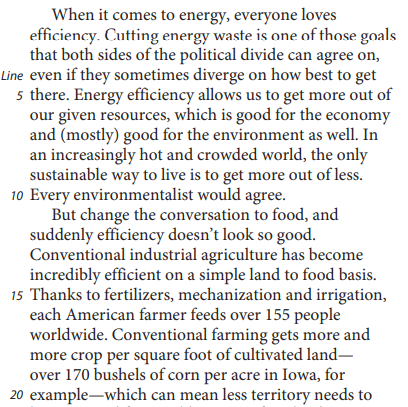
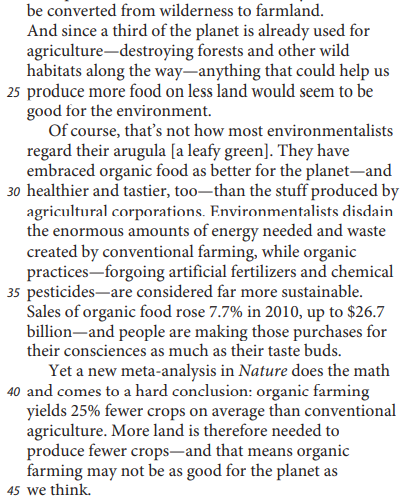
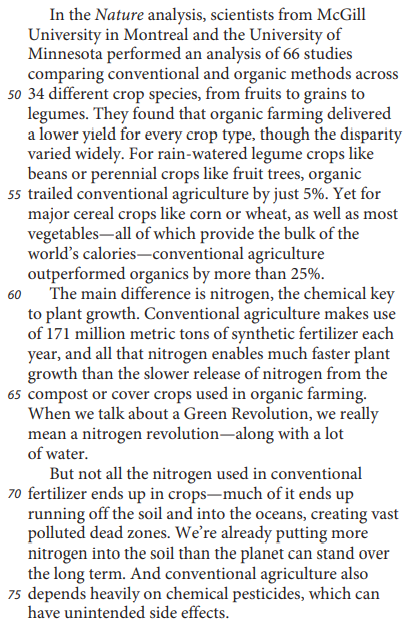
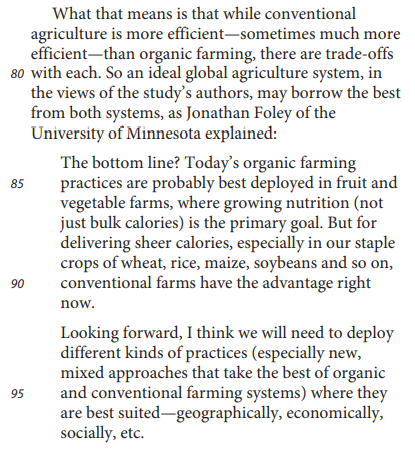
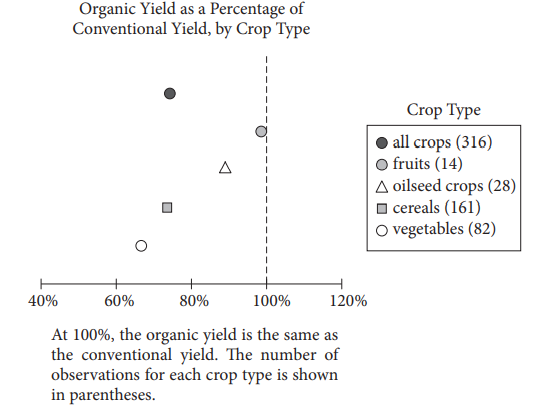
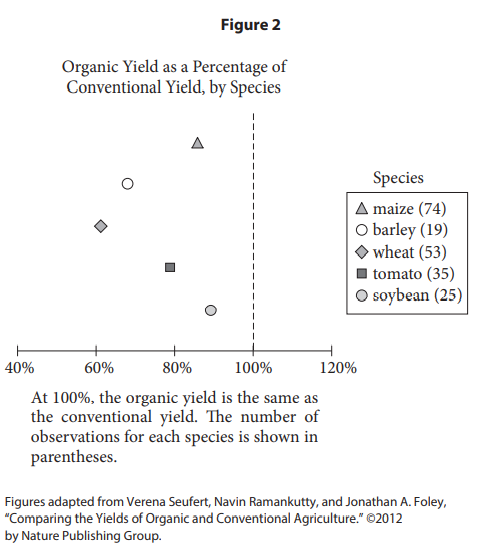
SAT Reading Comprehension Practice Test Questions
SAT Practice Test 23 Question No 1
As used in line 14, “simple” most nearly means
Option A: straightforward.
Option B: modest.
Option C: unadorned.
Option D: easy.
SAT Practice Test 23 Answer No 1
Show/Hide Answer
Option A :
In line 14, the passage states that industrial agriculture has become “incredibly efficient on a simple land to food basis.” In this context, “simple” suggests something basic or straightforward.
Choices B, C, and D are incorrect because, in the context of land to food dynamic, the word “simple” suggests something basic or straightforward, not something humble (choice B), something without any decoration or ornamentation (choice C), or something that requires little effort (choice D).
SAT Practice Test 23 Question No 2
According to the passage, a significant attribute of conventional agriculture is its ability to
Option A: produce a wide variety of fruits and vegetables.
Option B: maximize the output of cultivated land.
Option C: satisfy the dietary needs of the world’s population.
Option D: lessen the necessity of nitrogen in plant growth.
SAT Practice Test 23 Answer No 2
Show/Hide Answer
Option B :
The passage clearly states that conventional agriculture is very efficient, especially when compared to organic farming: “organic farming yields 25% fewer crops on average than conventional agriculture” (lines 40-42) and in a study “organic farming delivered a lower yield for every crop type” (lines 51-52). It can therefore be understood from the passage that conventional agriculture does a good job maximizing the output of the land that is farmed.
Choice A is incorrect because the passage states how efficient conventional agriculture is regarding the amount of food it can produce but does not indicate that it produces a significantly wide variety of fruits and vegetables. Choice C is incorrect because even if the passage does say that each American farmer can produce crops to feed “over 155 people worldwide” (lines 16-17), it never claims that conventional agriculture can satisfactorily feed everyone in the world. Choice D is incorrect because the passage states that conventional agriculture uses a great deal of nitrogen, not that it changes the need for nitrogen in plant growth one way or the other.
SAT Practice Test 23 Question No 3
Which choice best reflects the perspective of the “environmentalists” (line 27) on conventional agriculture?
Option A: It produces inferior fruits and vegetables and is detrimental to the environment.
Option B: It is energy efficient and reduces the need to convert wilderness to farmland.
Option C: It is good for the environment only in the short run.
Option D: It depletes critical resources but protects wildlife habitats.
SAT Practice Test 23 Answer No 3
Show/Hide Answer
Option A :
The passage makes it clear that “most environmentalists” (line 27) believe conventional agriculture produces food that is not as healthy as food produced through organic farming and that it is more harmful to the environment than organic farming is: many environmentalists “have embraced organic food as better for the planet—and healthier and tastier, too—than the stuff produced by agricultural corporations” (lines 28-31).
Choices B, C, and D are incorrect because they are not supported by the passage. The passage never states that many environmentalists believe that conventional farming reduces the need to convert wilderness to farmland (choice B), is in any way good for the environment (choice C), or protects wildlife habitats (choice D).
SAT Practice Test 23 Question No 4
Which choice provides the best evidence for the answer to the previous question?
Option A: Lines 27-28 (“Ofcourse… green”)
Option B: Lines 28-31 (“They… corporations”)
Option C: Lines 31-35 (“Environmentalists…sustainable”)
Option D: Lines 42-45 (“More… think”)
SAT Practice Test 23 Answer No 4
Show/Hide Answer
Option B :
The previous question asks how environmentalists perceive conventional agriculture, with the answer being that they believe it produces a product that is less healthy and more environmentally destructive than that produced by organic farming. This is supported in lines 28-31: “They have embraced organic food as better for the planet—and healthier and tastier, too—than the stuff produced by agricultural corporations.”
Choices A, C, and D are incorrect because the lines cited do not support the answer to the previous question about how environmentalists don’t view conventional agriculture’s ability to “produce more food on less land” (line 25) as beneficial to the environment. Choice C is incorrect because these lines address environmentalists’ view of the environmental effects of conventional and organic farming but not the taste or nutritional value of the food produced. Choice D is incorrect because these lines focus on a drawback to organic farming.
SAT Practice Test 23 Question No 5
Which statement best expresses a relationship between organic farming and conventional farming that is presented in the passage?
Option A: Both are equally sustainable, but they differ dramatically in the amount of land they require to produce equivalent yields.
Option B: Both rely on artificial chemicals for pest control, but organic farmers use the chemicals sparingly in conjunction with natural remedies.
Option C: Both use nitrogen to encourage plant growth, but the nitrogen used in conventional farming comes from synthetic sources.
Option D: Both create a substantial amount of nitrogen runoff, but only the type of nitrogen found in fertilizers used in conventional farming can be dangerous.
SAT Practice Test 23 Answer No 5
Show/Hide Answer
Option C :
The passage makes it clear that while both conventional and organic farming needs nitrogen for plant growth, conventional farming uses synthetic fertilizers and organic does not: “Conventional agriculture makes use of 171 million metric tons of synthetic fertilizer each year, and all that nitrogen enables much faster plant growth than the slower release of nitrogen from the compost or cover crops used in organic farming” (lines 61-65).
Choice A is incorrect because the passage does not state that conventional and organic farming are equally sustainable and does state that organic farming needs “more land” to produce “fewer crops” (lines 42-43) but does not indicate that it always requires dramatically more land. Choice B is incorrect because the passage does not state that organic farming uses artificial chemicals. Choice D is incorrect because the passage mentions nitrogen runoff only as a product of conventional farming, not organic farming, and does not indicate that only the nitrogen in conventional fertilizers is dangerous.
SAT Practice Test 23 Question No 6
Which choice provides the best evidence for the answer to the previous question?
Option A: Lines 13-14 (“Conventional… basis”)
Option B: Lines 22-26 (“And since… environment”)
Option C: Lines 51-53 (“They… widely”)
Option D: Lines 61-65 (“Conventional… farming”)
SAT Practice Test 23 Answer No 6
Show/Hide Answer
Option D :
The previous question asks about the relationship between conventional agriculture and organic farming, with the answer being that, unlike organic farms, conventional farms use synthetic fertilizers. This is supported in lines 61-65: “Conventional agriculture makes use of 171 million metric tons of synthetic fertilizer each year, and all that nitrogen enables much faster plant growth than the slower release of nitrogen from the compost or cover crops used in organic farming.”
Choices A, B, and C are incorrect because the lines cited do not support the answer to the previous question about the relationship between conventional and organic farming, instead of describing the efficiency only of conventional agriculture (choice A), discussing one perceived positive aspect of conventional agriculture (choice B), and highlighting a drawback of organic farming (choice C).
SAT Practice Test 23 Question No 7
According to Foley, an “ideal global agriculture system” (line 80)
Option A: focuses primarily on yield percentages and global markets.
Option B: considers multiple factors in the selection of farming techniques.
Option C: weighs the economic interests of farmers against the needs of consumers.
Option D: puts the nutritional value of produce first and foremost.
SAT Practice Test 23 Answer No 7
Show/Hide Answer
Option B :
The passage states that the authors of the study comparing conventional and organic farming have concluded that an “ideal global agriculture system” would “borrow the best from both systems” (lines 80-82). The quote from Jonathan Foley in lines 84-97 indicates that this ideal system would take into consideration many different factors, including the nutrition and calories offered by specific types of foods as well as different geographic, economic, and social needs.
Choices A and D are incorrect because the passage makes it clear that the “ideal global agriculture system” would consider multiple factors, not that it would focus mainly on productivity (choice A) or nutritional value (choice D). Choice C is incorrect because Foley states that the ideal system would consider economics but does not indicate that farmers’ economic interests would be weighed against consumers’ needs.
SAT Practice Test 23 Question No 8
In line 88, “sheer” most nearly means
Option A: transparent.
Option B: abrupt.
Option C: steep.
Option D: pure.
SAT Practice Test 23 Answer No 8
Show/Hide Answer
Option D :
The passage states that conventional agriculture can be superior to organic farming in terms of producing “sheer calories” (line 88). In this context, “sheer” most nearly means pure; the passage is referring to the pure number of calories delivered by foods.
Choices A, B, and C are incorrect because in the context of discussing the calories foods can provide, “sheer” suggests the pure number of calories. Also, it does not make sense to say that calories can be seen through (choice A), are somehow sudden or happen unexpectedly (choice B), or are at a very sharp angle (choice C).
SAT Practice Test 23 Question No 9
Which statement is best supported by the information provided in figure 1?
Option A: The organic yield as a percentage of conventional yield is greater for vegetables than for fruits.
Option B: The organic yield as a percentage of conventional yield is similar for cereals and all crops.
Option C: The reported number of observations for each crop type exceeds 82.
Option D: The organic yield as a percentage of conventional yield is greater for vegetable crops than it is for oilseed crops.
SAT Practice Test 23 Answer No 9
Show/Hide Answer
Option B :
Figure 1 shows that the organic yield as a percentage of conventional yield is similar for cereals and all crops, with both yielding roughly 75%.
Choice A is incorrect because figure 1 shows that the organic yield as a percentage of conventional yield is higher for fruits (just under 100%) than for vegetables (just under 70%). Choice C is incorrect because figure 1 shows there were only 28 observations for oilseed crops. Choice D is incorrect because figure 1 shows that the organic yield as a percentage of conventional yield is higher for oilseed crops (approximately 90%) than for vegetables (just under 70%).
SAT Practice Test 23 Question No 10
Which of the following claims is supported by figure 2?
Option A: Ofthe organically grown species represented, soybeans have the lowest yield.
Option B: The organically grown maize and barley represented are comparable in their yields to conventionally grown maize and barley.
Option C: Of the organically grown species represented, tomatoes have the highest yield.
Option D: The organically grown species represented have lower yields than their conventionally grown counterparts do.
SAT Practice Test 23 Answer No 10
Show/Hide Answer
Option D :
Every organically grown species represented in figure 2 produces a smaller yield than do their conventional counterparts. All of the organically grown species are within a range of approximately 60–90% of the conventional yield.
Choice A is incorrect because figure 2 shows that soybeans have the highest yield (approximately 90%), not the lowest. Choice B is incorrect because figure 2 shows that organically grown barley and maize are produced at a lower yield than the conventionally grown species (just below 70% and just below 90%, respectively), not a comparable one. Choice C is incorrect because figure 2 shows that soybeans, not tomatoes, have the highest yield of the organically grown species.






